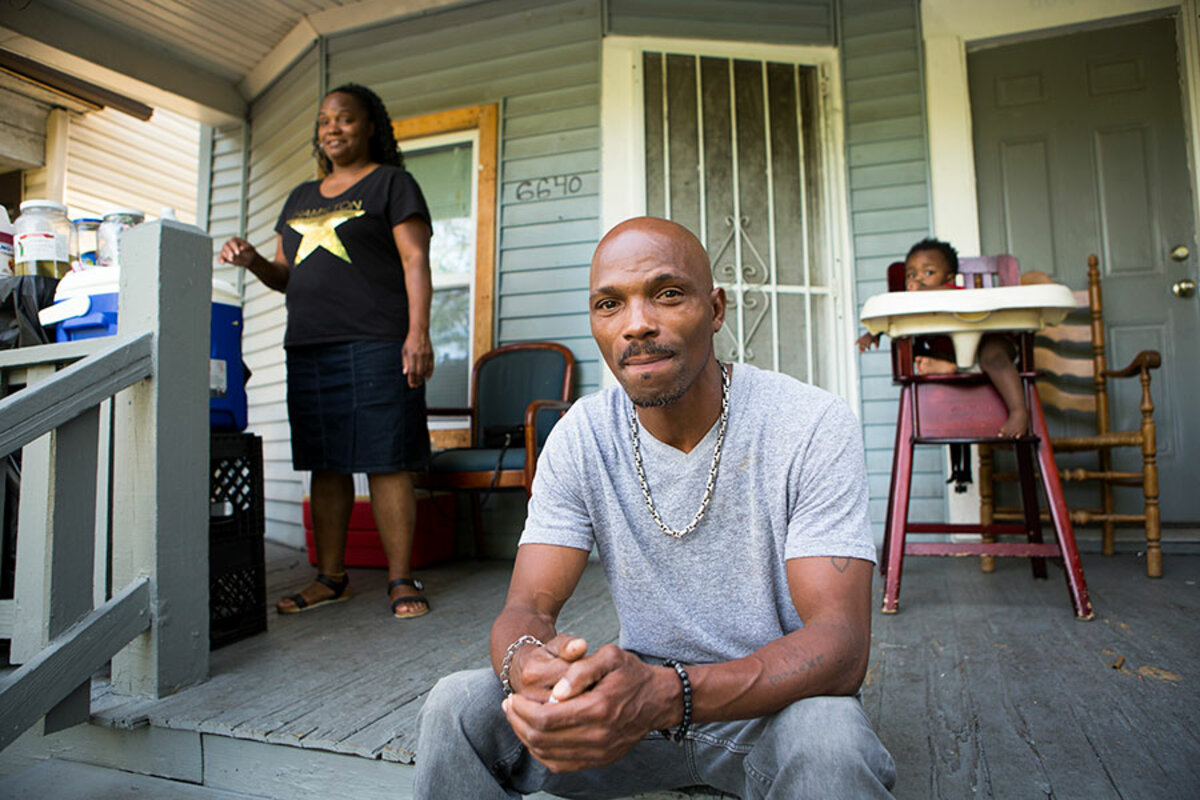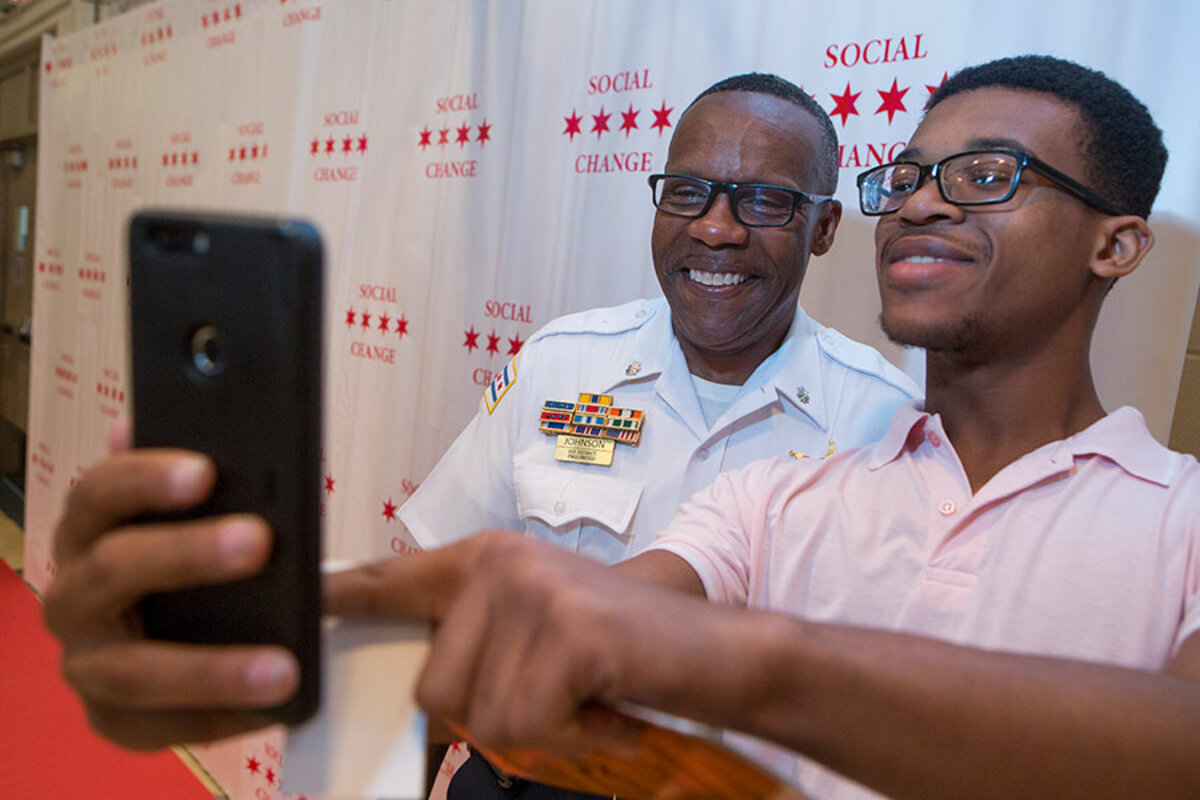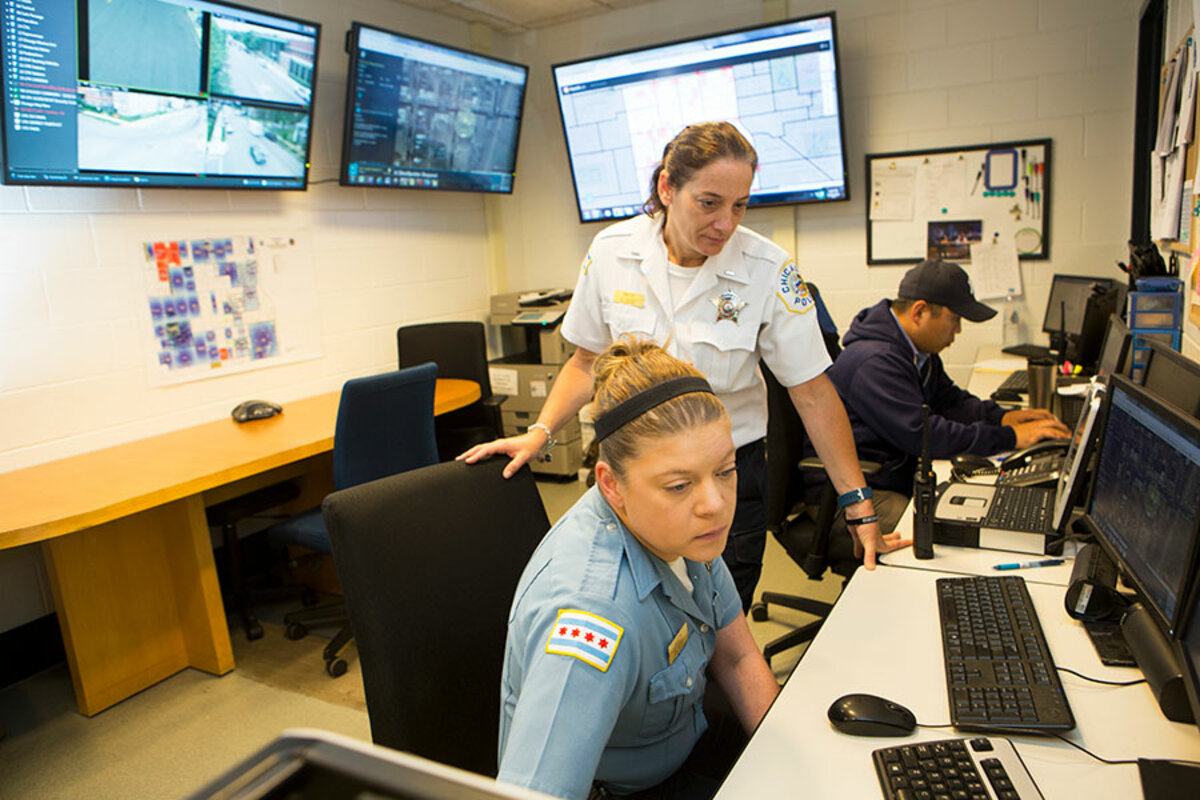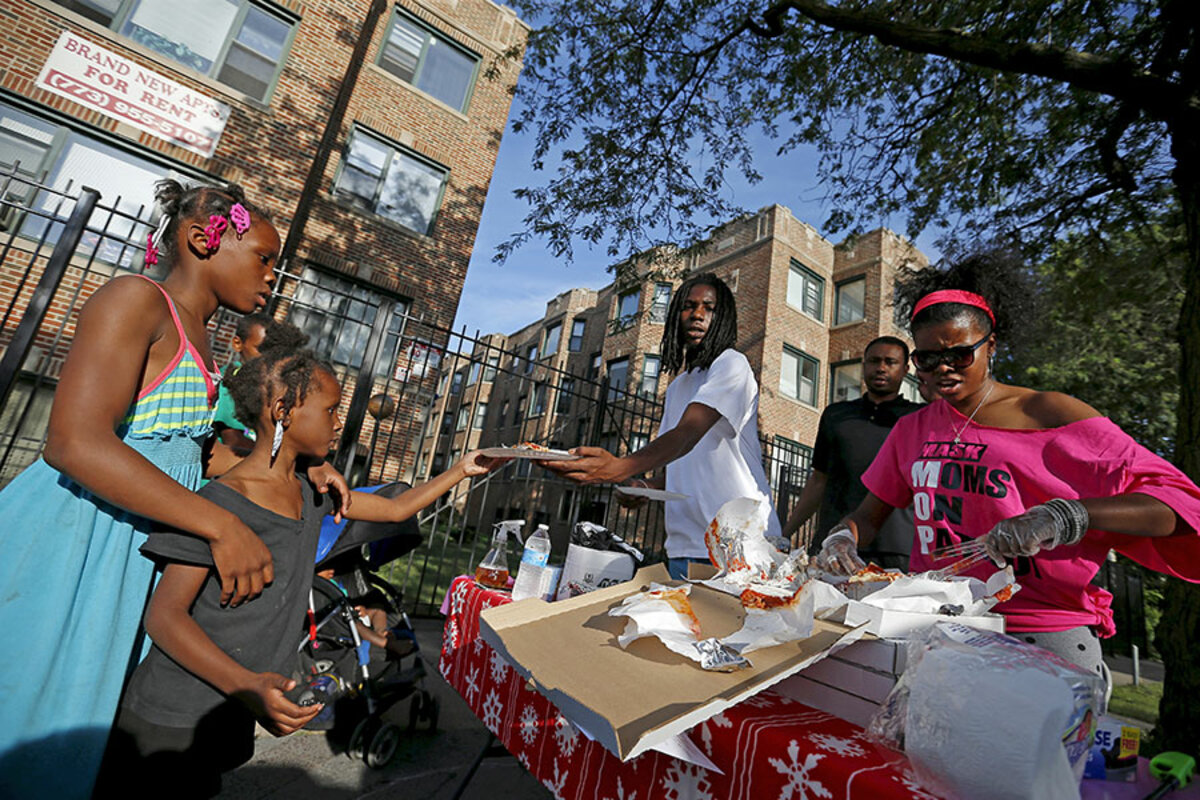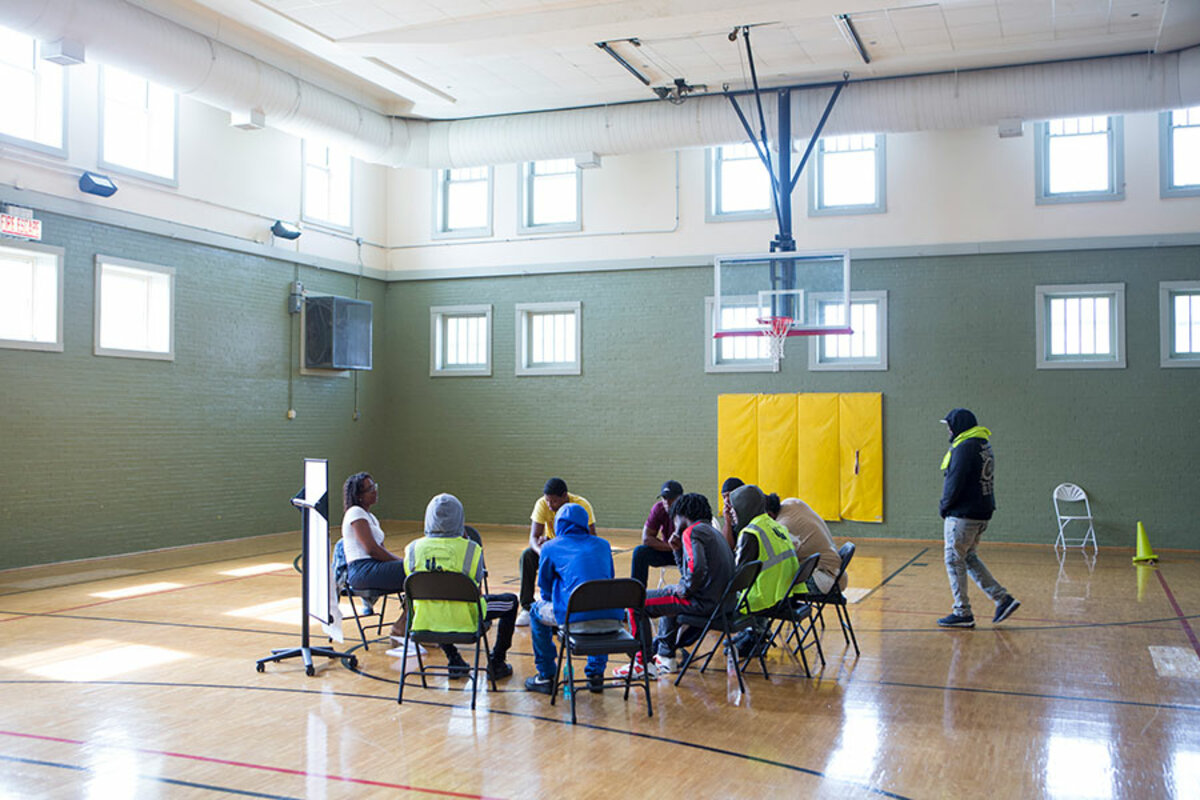Despite spike in shootings, a Chicago community gets a handle on violence
Loading...
| CHICAGO
On a recent Monday afternoon, a dozen boys and girls are shooting hoops at the outdoor courts of Ogden Park on Chicago’s South Side – something that not long ago, few dared to do in this neighborhood of Englewood, which has long struggled with gun violence.
“At one point, these guys couldn’t even come out and play ball,” says Chicago police officer Morris Brown, watching the teens from his patrol car. He grew up here and has spent the past 18 years serving as an officer in Englewood. “You’d go a whole day and no one would come out to the basketball court.”
Selling snow cones from their porch across the street, middle-aged twins Denise and Dennis Hamilton remember those darker days well. Their brother, Paul, was killed by stray bullets in the park in 2016.
Why We Wrote This
When the relationship between law enforcement and crime-ravaged communities is adversarial, it can perpetuate a dangerous cycle. But in this community, residents and police have converged to bring tangible progress.
“It was Labor Day and he was out walking the dog,” Denise recalls. Two others were killed by gunshots in the park that year, including a young man playing basketball with his brother.
That was Chicago’s most violent year in nearly two decades, with more murders than New York and Los Angeles combined. But since then, the city has made impressive strides toward becoming a safer place. Even as it struggles with spates of violence such as during the first weekend in August – when more than 75 people were shot and 12 died – Chicago has steadily reduced the number of shootings over the past two years. And Englewood is leading the way.
Even as Chicago has seen a steady decline in violence, this South Side neighborhood has cut its homicides and shootings by nearly double the rate seen citywide, reducing them by nearly half – the equivalent of saving 21 lives. In 2017, the neighborhood saw the lowest level of gun violence since the police department started keeping records in 1999.
The key to the reductions in Englewood, researchers and residents say, has been the coming together of community members and police officers targeting the people and places most plagued by violence. Here, mothers sit out on the most violent corners, police officials have reinvented how they deploy officers and work with the community, and a coalition of organizations provides therapy and job training to the men who are most likely to shoot or be shot.
And while gun violence remains a problem in this neighborhood, with 29 murders occurring in the first seven months of this year, the decline in violent crime is starting to be felt by people in the hardest-hit areas.
***
It was eight years ago this summer that Mario lost his 9-year-old sister, Chastity. She had been sitting outside washing her pit bull, Pinky, when gang members sped by in a van and started shooting, targeting her father in a gang-related conflict. He survived, but she was killed.
A few years ago, volunteers from a group called Mothers Against Senseless Killings started bringing their lawn chairs and sitting in a vacant lot just two blocks away. They feed neighborhood kids every evening during the summer.
At first, Mario didn’t know who they were or why they were there. But he’s gotten to know them over the years and even helps them hand out food now.
“They’ve made a big difference in the neighborhood,” he says. “People from everywhere come over here on this block to eat. A lot of people didn’t want to come out on this block before, but they come out here now. [The volunteers] helped stop the violence in the neighborhood.”
Located just two miles southwest of former President Barack Obama’s house, Englewood is a predominantly black and impoverished neighborhood. People here are 24 times more likely to die from gun violence than someone living in the city’s prosperous downtown Loop neighborhood.
In 2008, actress Jennifer Hudson’s mother, brother, and nephew were shot and killed here. The neighborhood was also the setting for Spike Lee’s 2015 musical film, “Chi-raq,” a retelling of Aristophanes’ Lysistrata centered on gang violence. But behind the headlines are systemic problems.
“This kind of gun violence really comes out of the continued conditions of disinvestment, lack of access to quality education with school closings, and minimal access to job opportunities,” says Tonika Johnson, program manager for the Resident Association of Greater Englewood.
In 2015, 36 percent of Englewood residents were unemployed and 58 percent made less than $25,000 a year. The neighborhood has struggled with population loss as people flee the violence and search for better economic opportunities. While there have been some glimmers of revitalization in recent years with the opening of a new Whole Foods grocery store and a $33 million outpatient care center, the effects of decades of disinvestment are not easily reversed. Many say it takes a community-wide effort.
“You can’t just expect policing to solve it. That’s not going to work,” says Ms. Johnson, who helps lead the neighborhood’s Public Safety Task Force. “You can’t just expect residents to be able to work alone to solve it. It really has to be a combination of things.”
On a recent Thursday evening, Johnson is among a dozen representatives from Englewood’s violence prevention organizations sitting in tired fabric chairs at Canaan Community Church eating baked chicken and green beans. Near the back is Seventh District Police Cmdr. Kenneth Johnson, fully at home in the church. He and his twin brother, Kevin – who aren’t related to Tonika – attended the Archbishop Quigley Preparatory Seminary in downtown Chicago and at one time considered becoming priests. Instead, they chose a different kind of service.
Kevin Johnson now commands a police district struggling with violence on Chicago’s West Side, while Kenneth leads the police in the Englewood neighborhood. Kenneth assumed command of the Seventh District in August 2016, as gun violence was soaring and the Department of Justice was investigating the Chicago Police Department for excessive use of force.
Seeing an opportunity to break with the police department’s controversial past, Kenneth adopted a new strategy in Englewood: Officers would take a more active role in the community and employ new technologies to predict and see violence as it is unfolding.
“We have to be more than police officers, more than law enforcement,” he says. “We have to be good community partners.”
So when three homicides took place at an Englewood park just after he took command in 2016, Kenneth worked with the park district, the local government representative, and community members to clean the park, trim the trees, and paint a field house. He also set up an enforcement area around the park so that officers paid more attention to the thriving drug market there. Since then, there hasn’t been a single shooting or homicide in the park.
The police commander’s strategy appears to be working across the neighborhood. A study conducted by the University of Chicago’s Crime Lab, which compared Englewood with similar areas around the city, found that nearly 80 percent of the decline in shootings in Englewood could be attributed to changes in policing, especially the establishment of a Strategic Decision Support Center in the district in February 2017. (The Crime Lab helped launch the SDSC, but it is an independent group.)
***
The SDSC is only the size of an apartment kitchen, but it has dramatically changed how quickly the police respond to shootings in Englewood and how they deploy their resources. Analysts and police officers hover over a bank of computers and maps showing crime data going back five years as well as predicted crime patterns provided by HunchLab.
“We find that the growing use of data-driven policing has had a particularly pronounced impact on gun violence in Englewood,” says Jens Ludwig, faculty director at the Crime Lab, adding that the new policing changes in the district accounted for as much as a 15 percent drop in Chicago’s overall decline in shootings from 2016 to 2017, despite Englewood making up only 3 percent of the city’s population.
Large-screen TVs on the walls of the SDSC stream video from about 120 surveillance cameras positioned across the district. Maps also show where officers are currently responding to calls and the location of recent gunfire detected by ShotSpotter,
a system of microphones dotting the neighborhood.
Lt. Laura West, who oversees the Seventh District SDSC, says the center has allowed officers to use this surveillance technology at the neighborhood level, as opposed to just in the department’s main headquarters. Cameras that used to be looked at only after an incident took place are now monitored 24 hours a day. All officers in the Seventh District have access on their smartphones to the maps and information developed by analysts in the SDSC room.
The change has meant that police are investigating shootings often before people start calling 911. When a gunshot is detected by ShotSpotter, its location lights up on one of the maps and the officers switch to a nearby high-definition surveillance camera.
“We can get to that corner before the [patrol officers] do and let them know what’s happening,” West says. “It’s a game changer, really.”
Getting to the scene of a shooting faster means that police can pick up evidence before it is destroyed or removed and even catch criminals in the act. While overall arrests are down, gun-related arrests are up 25 percent in the district from last year.
But the new center also means that the police are constantly watching community members, even those who are not committing a crime. On a recent day, an officer was switching from camera to camera following a black man in a red vest as he walked along the sidewalk, stopping at a gas station and chatting with some friends. He was not doing anything illegal, and wasn’t even aware that he was being observed.
It’s a controversial strategy in a city where black and Latino residents often complain about illegal stops and searches and surveillance by police. Chicago has one of the most extensive and integrated camera networks in the United States, and the American Civil Liberties Union of Illinois has pushed back against the SDSC.
“Residents and visitors to Chicago continue [to live] without protections from these powerful, invasive systems,” says Ed Yohnka of the ACLU of Illinois. “We remain concerned that the city of Chicago continues to expand intrusive surveillance systems – including the Strategic Decision Support Center and a proposal to expand the use of drone surveillance – without appropriate and necessary public transparency.”
***
Three miles to the south of Englewood’s SDSC, a different sort of eyes survey the streets. Sitting in hot pink lawn chairs, the volunteers of Mothers Against Senseless Killings (MASK) are watching over about a dozen kids eating pizza and brownies at a vacant lot on the corner of 75th and Stewart. One man rakes up trash, while two women plant flowers and vegetables.
Eight days earlier, before MASK had begun its summer sit-outs, this corner was a very different place. Empty chip bags and beer bottles were strewn throughout the lot. A group of young men were hanging out in front of the liquor store across the street, which advertised “cut rate” booze. Tension filled the air. That night, a 46-year-old man was shot four times in the back here. Thankfully, he survived.
Since 2015, MASK has been coming to this corner from 4 p.m. to 8 p.m. on most summer days, barbecuing and playing with neighborhood kids. A volunteer group that runs on donations, MASK regularly feeds as many as 150 kids and adults from the area. “This is called watching the kids,” says MASK founder Tamar Manasseh, who was inspired to start coming to this corner after a mother about her age was shot and killed here. “You watch over them and make sure nothing happens.”
Ms. Manasseh, a trained rabbi and mother of two, grew up in this area and today lives in the nearby Bronzeville neighborhood. She remembers a time when parents regularly sat outside on their porches to keep an eye on their kids. Now, it’s not uncommon for youths here to spend the whole summer indoors, with parents fearing for their safety.
In the four summers MASK has been coming to this corner there have been shootings, but only one murder. Beyond being a violence prevention program, however, Manasseh says the mission of MASK is about building resilience and a sense of community in a place that’s often painted as a war zone. Many of the women and men who volunteer with MASK have been impacted by gun violence themselves.
That includes Maria Pike, whose son, Rick, was shot while trying to park his car in a gentrifying neighborhood on Chicago’s West Side in 2012.
“The thing about being a survivor is it doesn’t matter who you are, what color you are, where you live – we all feel the same kind of grief,” says Ms. Pike, who couldn’t sleep through the night for two years after she lost her son. Now, with a man arrested for his murder, her focus is on connecting with other mothers affected by violence. “It doesn’t matter whether your son is on the wrong side of the fence or not, your grief is the same. And in order to have peace here, we have to become a community and we have to join forces with the mothers of the ones who hurt our kids.”
So Pike makes the nine-mile trek south from her home to Englewood as often as she can. Last year, she helped plant a vegetable garden on the lot that produced more than 20 pounds of tomatoes and a seemingly endless supply of lettuce.
“We had salads constantly!” she laughs. “The beautiful thing was people didn’t realize they were connecting with each other [through the garden]. Kids who passed by with their moms would ... check on the tomatoes and Papa King would explain to them how they grow,” she says, referring to a fellow MASK volunteer. “That interaction is so important.”
Last year, MASK gave out book bags and school uniforms to kids who needed them. They are now working with the Museum of Science and Industry in Chicago and the city government to build a small permanent community center on the block that would serve the area year-round and provide science, technology, engineering, and math classes to children. MASK has inspired people to form affiliate groups elsewhere in Chicago as well as in Indiana, New York, and Tennessee. But to permanently improve the neighborhood, Manasseh says, they would need help from the city to address the underlying causes of the violence.
“You want the violence to stop. But if we stop it, now what?” she asks. “What can you do for these people in these neighborhoods? You’re closing the schools. They don’t have jobs. They live in a food desert. What are you going to do?”
***
One answer lies in a community center a few miles north of the MASK site. There, a social services agency is trying to give men more choices, men like Terrence Jackson.
Mr. Jackson doesn’t look like someone most at risk for gun violence in Chicago. At 6 feet 5 inches, the Englewood native cuts a gentlemanly form, wearing a maroon shawl-neck cardigan and jeans.
But one of the things that sets this program apart is its use of big data to find the people who most need its services. While police departments, including Chicago’s, use predictive algorithms to find the individuals most likely to commit crimes, this seems to be the first time that nongovernmental organizations have used analytics to connect those individuals to social services.
“Before I got the call about a job at READI [Rapid Employment and Development Initiative], I was nine toes in the street – selling drugs, robbing, [using] guns,” says Jackson. “When you’ve got kids and bills, you resort back to what you know. Because you’ve got to provide for your kids, even though it’s not right.”
READI, launched by the global antipoverty group Heartland Alliance in response to violence here in 2016, enrolls men in an 18-month program of intense cognitive behavioral therapy and supported job training. It also provides them with legal and social services along the way. Studies have shown cognitive behavioral therapy to reduce violent arrest rates, especially when combined with employment training.
The initiative has a $32 million budget for its first two years and works in four communities in Chicago, including Englewood. Organizers hope to connect 500 men to jobs by the spring of 2019. They’re almost halfway there. The participants are mostly African-American and between the ages of 18 and 32. Eighty-one percent have lost a loved one to violence and almost all have been arrested before – 16 times, on average.
Jackson grew up in a single-parent home and started using drugs and getting involved with a gang before he was a teenager. At 10 years old, he was shot in the back. Over the next 17 years he was in and out of jail, mostly for getting into fights and destroying property.
Then, in 2009, Jackson was arrested for committing a series of armed robberies of AutoZones. He says he was trying to get money to buy a present for his son, who was turning 1. He ended up spending eight years in prison.
After he was released last summer, Jackson struggled to find a job. Although he had picked up a few trades while incarcerated, no one wanted to hire someone with a criminal record. Then he was selected for READI.
To be sure, the program faces challenges. Six men selected for READI – including two who had already started working – have been shot since the program started.
While READI is still in its early stages, staff point to positive benchmarks, such as high job attendance, that indicate the program is making a difference. Even participants living out of their car or on friends’ couches are still making it to work regularly.
“I think the program is great,” says Jackson, who now spends three mornings a week in therapy and works part time with the Chicago Park District. “I look at it like, for all the negative I’ve done, I get to give back. We don’t have a lot of good programs in Chicago for us to help us do something great. We have a lot of jails and police stations, but not enough resources.”
***
Progress at reducing gun violence can be painstakingly slow, even with the success of neighborhoods like Englewood. And the progress can be uneven: Even as the city’s overall violence went down over the past two years, the number of children shot in Chicago has remained steady.
Questions also persist about how sustainable the current trend is. The spike in gun violence that Chicago and other places experienced in 2016 came after a long period of decline. Some are concerned that the city’s recent success may be reversed, and point to the violence this past weekend as evidence of just how fragile the peace here is. But for the people most affected by gun violence, even small changes can seem like victories.
Out on the streets of Englewood, Jackson agrees that he and the other men are changing and transforming their neighborhood – and themselves. As part of his job training with the city parks agency, Jackson and a dozen other participants are working their way down Garfield Boulevard on this day picking up trash. As the men walk toward the highway, they joke with each other. Jackson will walk 15 blocks with his crew, a harbinger of peace in and of itself.
“A lot of guys can’t walk from block to block in their neighborhood,” Jackson says, because they can’t cross gang territories. “But here, we walk together.”





